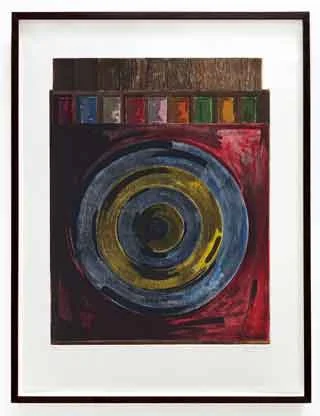Target with Four Faces
(ULAE 203), 1979
paper: 29 7/8 x 22 1/8 inches
image: 23 1/2 x 18 1/4 inches
frame: 31 3/8 x 23 3/4 inches
edition: 88 with 13 AP's & 2 PP's
signed & dated in pencil "J Johns '79" lower right
numbered in pencil lower left
printed by Atelier Crommelynck
published by Petersburg Press, New York
© 2024 Jasper Johns / Licensed by VAGA at Artists Rights Society (ARS), NY
Literature
Judith Goldman, Jasper Johns Prints 1977-1981, Thomas Segal Gallery, Boston, MA, 1981, n.p., Segal 17, another impression reproduced full page black and white.
Richard Field, The Prints of Jasper Johns 1960-1993: A Catalogue Raisonne, ULAE, New York, 1994, Catalogue Reference ULAE 203, n.p., another impression reproduced in full-page color.
Carlos Basualdo, Scott Rothkopf, Jasper Johns Mind/Mirror, Whitney Museum of American Art, 2021, another impression reproduced plate 30, pg. 294.
Elizabeth Armstrong, Jasper Johns: Printed Symbols, Walker Art Center, 1990, pgs. 64-65, another impression reproduced in full-page color.
Exhibited
The Museum of Modern Art, New York, Jasper Johns: A Print Retrospective, May 19–Aug 19, 1986, another impression exhibited.
Walker Art Center, Minnesota, Jasper Johns: Printed Symbols, February 18-May 13, 1990, another impression exhibited.
The Museum of Fine Arts, Houston, Jasper Johns: Printed Symbols, June 17-August 19, 1990, another impression exhibited.
The Fine Arts Museums of San Francisco, San Francisco, Jasper Johns: Printed Symbols, September 15-November 18, 1990, another impression exhibited.
Montreal Museum of Art, Montreal, Jasper Johns: Printed Symbols, December 14, 1990-March 10, 1991, another impression exhibited.
Saint Louis Art Museum, St. Louis, Jasper Johns: Printed Symbols, April 6-May 27, 1991, another impression exhibited.
Center for the Fine Arts, Miami, Jasper Johns: Printed Symbols, June 22-August 18, 1991, another impression exhibited.
The Brooklyn Museum, Brooklyn, Jasper Johns: Printed Symbols, September 14-November 10, 1991, another impression exhibited.
Whitney Museum of American Art, New York, Jasper Johns Mind/Mirror, September 29, 2021-February 13, 2022, other impressions exhibited.
Selected Museum Collections
Philadelphia Museum of Art, Philadelphia
National Gallery of Art, Australia
Los Angeles County Museum of Art, Los Angeles
Walker Art Center, Minneapolis
National Gallery of Art, Washington D.C. — includes eleven trial proofs, working proofs and state proofs of Target with Four Faces, 1979 by Jasper Johns






